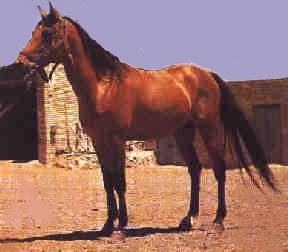

Persian Arab


Introduction: These are horses of an ancient, fiery and elegant breed, believed by some to be older than the desert Arabian of Jordan. They are of national importance in Iran. If you have any comments or suggestions, please click here.
Names: Persian Arab.
Origin: The bones of a horse excavated in western Iran prove that the Arab existed there long before domestication. They also show that the Arab has changed very little since prehistoric times, man having had little influence over its build or appearance. The Iranians have always claimed that they were the first to domesticate the Arab, and the Persian Arab is one of the oldest pure Arab lines in the world. It has been very carefully maintained through selective breeding and attention to purity of line.
Breeding: The Persians (Iranians) have always imported Arab horses from the Negev to supplement and improve their breeding; according to their parentage the resulting progeny is called Hoor if both parents are Arab, Beradi if only the mother is Arab, and Hedijn if only the father is Arab.
Description: Different strains of Arab have developed which vary slightly from each other in type and size according to climate, pasture, and national preferences. Raised in a temperate area, the Persian Arab is larger and softer than its desert-bred cousins, and does not have the typical "dished" face. It is a strong horse of athletic build and Arab type, but taller, with an elegant, compact body. Although considerably more robust in build, in the shape of the head and general liens the Persian Arab closely resembles the Arab, of which it can be considered a variety, presumably having common origins or being derived from it. (Some believe the Arab was derived from the Persian Arab!)
Color: Bay, chestnut or gray; rarely black.
Size: 14.1 to 15.1 hands (1.45 to 1.53 meters).
Temperament: Spirited and energetic. Intelligent, lively, and kind.
Features: Fast, with stamina.
Uses: Principally used for riding and improving other breeds.
Accomplishments:
Curiosities:
Profiles:
Conclusion:
Iran * Search-Terms * Diagrams